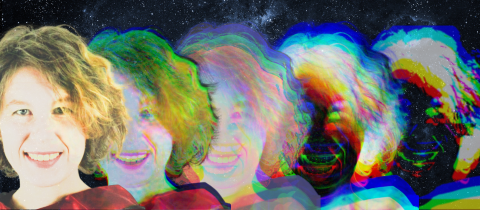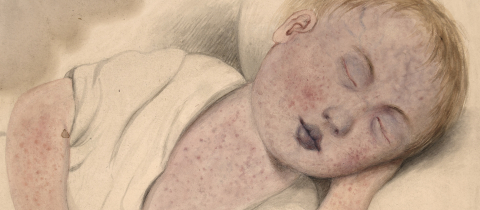It was inside a tiny restaurant on Clerk Street in Edinburgh, Scotland, that I spotted the pamphlets. I was waiting for my meal, sitting in front of a narrow ledge that served as both a table and an area to drop off promotional items for local businesses. Near my placemat was a pile of these pamphlets and they boldly declared, “The Truth About Drugs.”
I flipped through one of them. It was printed on cheap newspaper stock. Its unnerving photos of drug-addled teenagers and syringes were rendered in shades of blue-green that reeked of despair. Whether you were interested in cocaine, cannabis, or alcohol, the pamphlet acted as a dire warning. “Armed with this information,” it concluded at the back, “the reader can make the decision to live a drug-free life.”
This booklet, which is available in many languages, was produced by the Foundation for a Drug-Free World, which also released a digital copy of it. While reading this pamphlet may lead you to assume it came from well-intentioned people who simply want to protect our youth, there is a more sinister angle not explicitly mentioned in the pages of “The Truth About Drugs.”
When looking up on Google Maps the street address that is listed on the website of the Foundation, I was led to the corner of Hollywood Boulevard and Ivar Avenue in Los Angeles. Atop the massive pillars propping up the edifice, tall letters spelled out, “The L. Ron Hubbard Life Exhibition.” I had arrived at one of the many buildings belonging to the Church of Scientology.
Scared straight
The origin story for Scientology was devised by its founder, L. Ron Hubbard, a prolific pulp fiction writer who still holds the Guinness World Record for most published works by one author: 1,084.
This creation myth used to only be revealed to members at the upper levels of the organization but has since been leaked, raising a few eyebrows along the way. Seventy-five million years ago, the story goes, there was an alien civilization looking very much like 1950s America and controlled by Supreme Ruler Xenu. This tyrannical overlord had many of his people flown to a prison planet, Earth, where their frozen bodies were dropped from space planes and into volcanoes. Hydrogen bombs were exploded on top of each volcano, and the spirits from these slaughtered aliens floated freely and started leaping inside our human bodies, becoming like souls. These spirits, known as thetans, are blamed by Scientology for our fears and neuroses, but we can allegedly be cleansed of them through a number of interventions that have been denounced by former members.
Scientology has funded anti-drug campaigns and substance use programs, chief among them Narconon which, despite its name, has no relation to Al-Anon or to Alcoholics Anonymous. While interviewed on the IndoctriNATION podcast, Narconon’s former president, Lucas Catton, revealed that the program’s outreach to school students categorized all drugs as poisons. It was pushing the idea of “making children sort of become anti-medicine, anti-doctors, anti-psychiatrists.” Pharmaceuticals were put in the same box. The message was that if you take too much aspirin, for example, it could kill you. Technically true, but it emphasizes small risks in the name of scaring young, impressionable minds away from drugs entirely.
This scaremongering attitude is on full display in “The Truth About Drugs” booklet, in which we are erroneously told that “drugs are essentially poisons,” and that painkillers, tranquilizers, antidepressants, sleeping pills, and stimulants may appear safe because doctors prescribe them, but “they can be just as addictive and potent as the heroin or cocaine sold on the street.”
Cannabis does not escape from being painted as a villain. The booklet mentions that kids who use marijuana are five times more likely to steal and almost four times more likely to act violently or damage property. These figures are offered here without references; elsewhere, they are sourced to the 1998 version of the National Survey on Drug Use and Health, released by the Substance Abuse and Mental Health Data Archive (SAMHDA). Based on self-reports, weekly cannabis users were found to be five times as likely as nonusers to say they stole from places other than home, and teenagers aged 12 to 17 were three or more times more likely than nonusers to say that they had, in the past year, purposely damaged property that wasn’t theirs. The problem here is in jumping the gun from correlation to causation. These self-reports do not show that cannabis causes criminal behaviour. In fact, the two could be correlated because of risk factors that affect both: low socioeconomic status, poor achievement in school, behavioural problems, and poor family relations, for example. To fail to mention this important hole in our understanding serves to paint cannabis as a boogeyman. It also fails to distinguish between heavy adolescent marijuana users and occasional users, who are very different in many ways.
We’re not far from the propaganda of 1936’s Reefer Madness, in which cannabis was called “a violent narcotic” whose consumption would often end in “incurable insanity.” And the booklet’s monochromatic photos of a homeless man clutching his bottle of booze and of a girl huddled up in a corner in the foetal position also reek of the Scared Straight approach. The idea behind Scared Straight is that exposing at-risk youth to the realities of prison will convince them to stay away from criminal activities in general. But studies have shown that this approach, which emphasizes the severity of the punishment, backfires and makes it more likely they will commit future offenses and go to jail.
In the context of drug use specifically, fear-based appeals in public service announcements have shown mixed results, and many experts have made the point that tapping into a fear of consequences can create resentment and stigma. Stigmatizing substance use can make it harder for someone dealing with a substance use disorder to seek help.
If scaring teenagers away from drugs is unlikely to be particularly effective, what has research shown does work to reduce harm?
“Fully vetted”
Even when putting the fear factor aside and looking at mass-media campaigns aimed at reducing illicit drug use in general, it is hard to draw conclusions on their effectiveness, in large part because of how different these campaigns are. In a 2015 summary of the evidence, eight mass-media interventions showed no effectiveness, four were beneficial, and two seemingly backfired and were associated with an increase in drug use.
Many of these campaigns, as well as school programs, address substance use as something that must be avoided, if not outright shunned. It is a top-down approach wielded by figures of authority and constitutes, as two researchers put it, “a form of denial, by adults, about the actual behaviours of teenagers and young adults.” Substances like drugs and alcohol are framed as solutions to distress, and their use as a momentary lapse in judgment. More reasonable campaigns have aimed for harm reduction through the provision of information.
I want to make it abundantly clear that I am not claiming that cannabis, alcohol, and hard drugs like cocaine are harmless. Addiction is very real; alcohol is a known cancer-causing agent; and even smoking cannabis, an activity that has been normalized in many countries and is sometimes claimed to have near-miraculous health benefits, can increase your chances of developing lung problems. But attempting to scare teenagers and young adults away from substance use can actually create harm and when, in a panic, we reach for any kind of material to help sell our message—material like The Foundation for a Drug-Free World’s Truth About Drugs pamphlet—it can lead to unforeseen consequences.
In 2017, a high school in Santa Monica, California, scrapped its anti-drug program after three assemblies had already been held. The reason? Parents learned that the program was led by the Foundation for a Drug-Free World, which is affiliated with the Church of Scientology. A district spokesperson told CBS News that the school principal had “fully vetted this organization.”
And lest you think people know better now, the Foundation participated in a back-to-school event last August, a gathering that was organized by Washington, DC’s Deputy Mayor for Public Safety. The report published by the Associated Press, which is actually a press release from the Foundation itself, captions a photo from the event thusly: “Kids are excited to receive free backpacks filled with school supplies and get drug education materials which arm them with tools against dangerous drugs.”
The self-promoting article reveals toward the end its ties to the Church of Scientology and claims that its Truth About Drugs program is one of the world’s largest nongovernmental drug education and prevention campaign.
It certainly reached me all the way over in Scotland. But like Reefer Madness, it should be called out for what it really is: propaganda.
Take-home message:
- “The Truth About Drugs” pamphlet is made by the Foundation for a Drug-Free World, which is affiliated with the Church of Scientology
- It uses scary images and unsourced claims to convince teenagers to stay away from drugs, including pharmaceuticals
- Fear-based anti-drug campaigns have showed mixed results and can create stigma, which makes it harder for people with a substance use disorder to seek help







